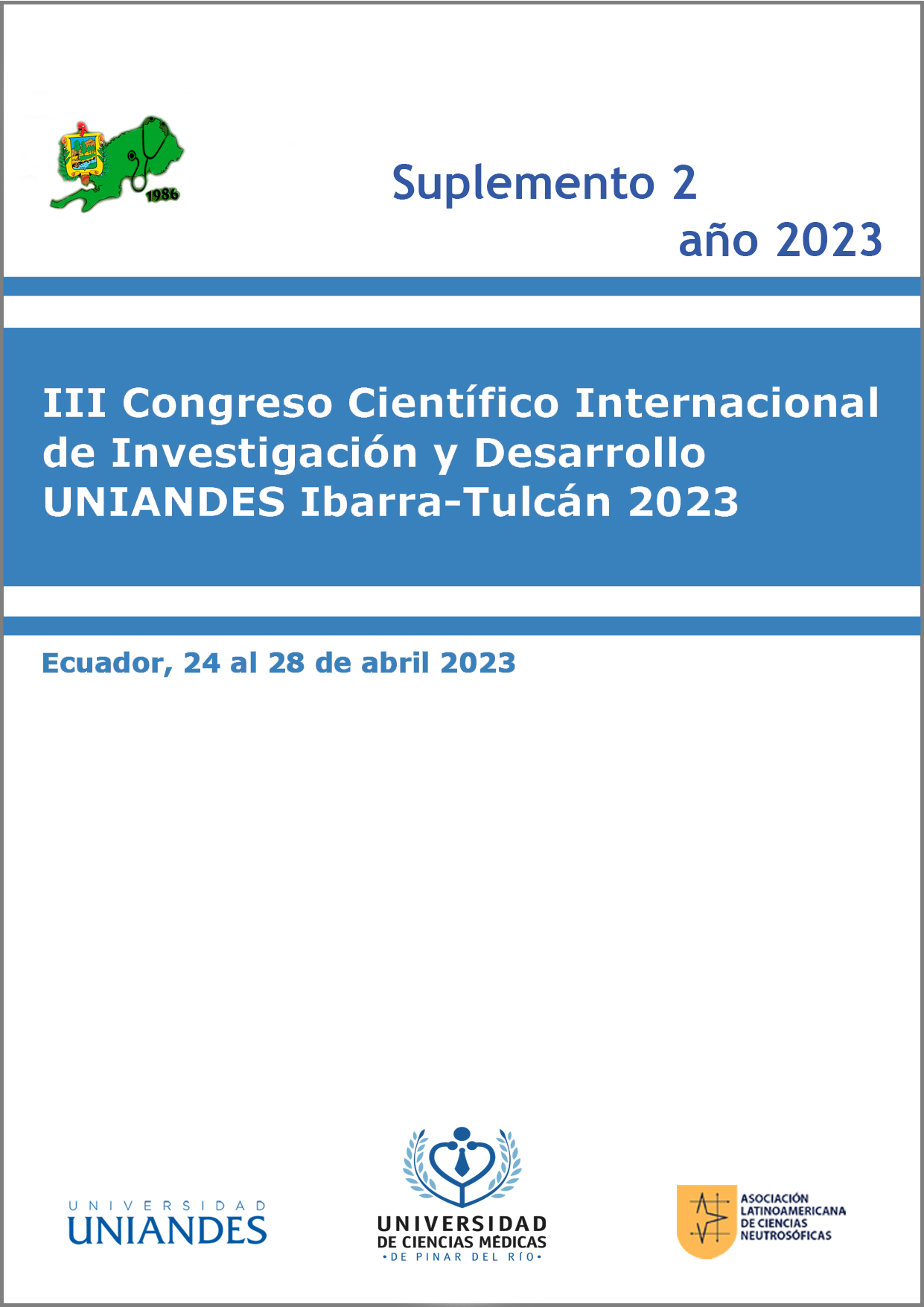Some considerations on Marfan syndrome linked to the FBN1 gene
Keywords:
MARFAN SYNDROME, AORTIC ROOT ANEURYSM, GENETIC DISEASES, MITRAL VALVE PROLAPSE.Abstract
Marfan syndrome is a rare autosomal dominant disease due to changes in the FBN1 gene that develops with cardiovascular (aortic root dilatation is evident), ocular (lens dislocation is typical, although the most recurrent is myopia) and musculoskeletal problems, mainly. Its diagnosis is made according to the Ghent scale, although in the field of pediatrics it is not so evident, since the clinical manifestations of Marfan syndrome appear in progress over the years. Therefore, in children who do not meet the diagnostic criteria, a definitive diagnosis of any other pathology should not be made until the age of 20 years. In these cases, if the patient has a pathogenic mutation of the FBN1 gene, they will be temporarily diagnosed with potential Marfan syndrome. On the other hand, if they do not have a pathogenic mutation of the FBN1 gene, they will be provisionally diagnosed with nonspecific connective tissue disease.
Downloads
References
1. Ahn NU, Sponseller PD, Ahn UM, Nallamshetty L, Kuszyk BS, Zinreich SJ. Dural ectasia is associated with back pain in Marfan syndrome. Spine[Internet]. 2020[citado 12/02/2022]; 25(12): 1562-8. Disponible en: https://pubmed.ncbi.nlm.nih.gov/10851107/
2. Ahn NU, Sponseller PD, Ahn UM, Nallamshetty L, Rose PS et al. Dural ectasia in the Marfan's syndrome: MR and CT findings and criteria. Genet Med[Internet]. 2020[citado 12/02/2022]; 2(3): 173-179. Disponible en: https://www.gimjournal.org/article/S1098-3600(21)00242-2/pdf#:~:text=Results%3A%20Major%20criteria%20include%3A%20(,2%20minor%20criteria%20are%20present.
3. Bisconti M, Bisetti A, Biddi P. Malignant mesothelioma in subjects with Marfan's syndrome and Ehlers-Danlos syndrome: Only an apparent association? Respiration[Internet]. 2020[citado 12/02/2022]; 67(2): 223-228. Disponible en: https://pubmed.ncbi.nlm.nih.gov/10773800/
4. Bresters D, Nikkels PG, Meijboom EJ, Hoorntje TM, Pals G, Biemer FA. Clinical, pathological and molecular genetic findings in a case of neonatal Marfan syndrome. Acta Pediatr[Internet]. 1999[citado 12/02/2022]; 88(1): 98-101. Disponible en: https://pubmed.ncbi.nlm.nih.gov/10090557/
5. Dietz HC, Pyeritz RE. Mutations in the human gene for fibrillin-1 (FBN-1) in the Marfan's syndrome. Hum Mol Genet[Internet]. 1995[citado 12/02/2022]; 4: 1799-809. Disponible en: https://pubmed.ncbi.nlm.nih.gov/8541880/#:~:text=Mutations%20in%20FBN1%20produce%20Marfan,due%20to%20mutations%20in%20FBN2.
6. Fietta P, Manganelli P. Coexistent Marfan's syndrome and ankylosing spondylitis: A case report. Clin Rheumatol [Internet]. 2001[citado 12/02/2022]; 20: 140-142. Disponible en: https://pubmed.ncbi.nlm.nih.gov/11346228/
7. Furthmayr H, Francke U. Ascending aortic aneurysm with or without features of Marfan's syndrome and other fibrillinopathies: new insights. Semin Thorac Cardiovasc Surg[Internet]. 1997[citado 12/02/2022]; 9(3): 191-205. Disponible en: https://pubmed.ncbi.nlm.nih.gov/9263339/
8. Kornbluth M, Schnitther I, Eyngorina I, Gasner C, Liang DH. Clinical outcome in the Marfan's syndrome with ascending aortic dilatation followed annually by echocardiography. Am J Cardiol[Internet]. 2019[citado 12/02/2022]; 84(6): 753-755. Disponible en: https://www.ajconline.org/article/S0002-9149(99)00430-0/fulltext
9. Manchola A, Gran F, Teixidó G, López F, Rosés F, Sabaté A. Síndrome de Marfán y síndrome de Loeys-Dietz en la edad pediátrica: experiencia de un equipo multidisciplinar. Rev Esp Cardiol[Internet]. 2018[citado 12/02/2022]; 71(7): [aprox. 5p.]. Disponible en: https://www.revespcardiol.org/es-sindrome-marfan-sindrome-loeys-dietz-edad-articulo-S0300893217302269
10. McKusick VA. The defect in Marfan ́s syndrome. Nature 2018; 325: 279.
11. Ng DK, Chau KW, Black C, Thomas TM, Mak KL, Boxer M. Neonatal Marfan's syndrome: a case report. J Pediatr Child Health[Internet]. 1999[citado 12/02/2022]; 35(3): 321-323. Disponible en: https://pubmed.ncbi.nlm.nih.gov/10404462/
12. Oosterhof T, Groenink M, Hulsmans FJ, Mulder BJ, Van der Wall EE et al. Quantitative assessment of dural ectasia as a marker for Marfan's syndrome. Radiology[Internet]. 2001[citado 12/02/2022]; 220(2). Disponible en: https://doi.org/10.1148/radiology.220.2.r01au08514
13. Padilla RA. Tejido conectivo. En: Padilla RA. Atlas de histología, tu ayudante personal. 2da ed. La Paz, Bolivia: Sagitario,1999; 17.
14. Robinson PN, Booms P. The molecular pathogenesis of the Marfan's syndrome. Cell Mol Life Sci[Internet]. 2001[citado 12/02/2022]; 58(11): 1698-1707. Disponible en: https://pubmed.ncbi.nlm.nih.gov/11706995/#:~:text=Mutations%20in%20the%20gene%20for,and%20homeostasis%20of%20elastic%20fibers.
15. Sponseller PD, Ahn UN, Nallamshetty L, Rose PS, Kuszyk BS, Fishman EK. Osseous anatomy of the lumbosacral spine in Marfan's syndrome. Spine[Internet]. 2000[citado 12/02/2022]; 25(21): 2797-2802. Disponible en: https://doi.org/10.1097/00007632-200011010-00012
16. Thaurin RC, De Monleon JV, Nivelon CA, Huet F. Association of Marfan's syndrome and Turner ́s syndrome. J Pediatr Endocrinol Metab[Internet]. 2001[citado 12/02/2022]; 14(9): 1661-1663. Disponible en: https://pubmed.ncbi.nlm.nih.gov/11795658/
17. Lucas RV, Edwards JE. The floppy mitral valve. Current problems in cardiology[Internet]. 1984[citado 12/02/2022]; 7(4): 1–48. Disponible en: https://doi.org/10.1016/0146-2806(82)90016-0
18. Cole WG, Chan D, Hickey AJ, Wilcken DE. Collagen composition of normal and myxomatous human mitral heart valves. The Biochemical journal. [Internet]. 1984[citado 12/02/2022]; 219(2): 451– 460. Disponible en: https://doi.org/10.1042/bj2190451
19. Pitcher A, Spata E, Emberson J, Davies K, Halls H, Holland L, et al. Angiotensin receptor blockers and β blockers in Marfan syndrome: an individual patient data meta-analysis of randomised trials. Lancet [Internet]. 2022 [citado el 03/04/2023]; 400(10355): 822–31. Disponible en: https://www.thelancet.com/journals/lancet/article/PIIS01406736(22)01534-3/fulltext
Downloads
Published
How to Cite
Issue
Section
License
Authors who have publications with this journal agree to the following terms: Authors will retain their copyrights and grant the journal the right of first publication of their work, which will be publication of their work, which will be simultaneously subject to the Creative Commons Attribution License (CC-BY-NC 4.0) that allows third parties to share the work as long as its author and first publication in this journal are indicated.
Authors may adopt other non-exclusive license agreements for distribution of the published version of the work (e.g.: deposit it in an institutional telematic archive or publish it in a volume). Likewise, and according to the recommendations of the Medical Sciences Editorial (ECIMED), authors must declare in each article their contribution according to the CRediT taxonomy (contributor roles). This taxonomy includes 14 roles, which can be used to represent the tasks typically performed by contributors in scientific academic production. It should be consulted in monograph) whenever initial publication in this journal is indicated. Authors are allowed and encouraged to disseminate their work through the Internet (e.g., in institutional telematic archives or on their web page) before and during the submission process, which may produce interesting exchanges and increase citations of the published work. (See The effect of open access). https://casrai.org/credit/



